Discover with us all the important information about the Mesoamerican culture that developed since ancient times on the continent. Don't stop reading it! and you will learn about the great variety of ethnic groups in the area.

The 10 Most Important Mesoamerican Cultures
The Mesoamerican cultures were a series of aboriginal civilizations that developed in Mexico and Central America before the arrival of the Spanish in the XNUMXth century.
By the time of the arrival of the Spanish, more than a dozen cultures were found in Mesoamerica: Olmecs, Mayas, Mexica/Aztecs, Toltecs, Teotihuacans, Zapotecs, Purépechas, Huastecas, Tlaxcaltecas, Totonacs, and Chichimecas. In this article, we will focus on the most important.
According to archaeologists, there is evidence that Mesoamerica has been populated by humans since 21,000 BC. These early Mesoamerican peoples were nomads.
However, in the year 7000 a. C., the melting of the glaciers allowed the development of agriculture, which made these aborigines begin to be sedentary.
With the improvement of cultures, the foundations for the creation of civilizations have been strengthened. From 2300 BC. C., artistic activities such as ceramics and architecture were developed.

Originally, it was believed that the Mesoamerican cultures originated at the same time. However, scholars of the region have shown through archaeological evidence that these civilizations arose at different times. Similarly, they met their end in different years.
Olmec culture
This ethnic group called the Olmec originated in southeastern Mexico between 1600 and 1400 BC. C. and it is believed that it disappeared around the year 400 a. c.
These natives laid the foundations that allowed the development of other Mesoamerican cultures and greatly influenced the Mayan and Aztec civilizations.
Considered the mother of all Mesoamerican cultures, since it is one of the first to be recorded, its name in the Nahuatl language means "people from the land of rubber" and, in fact, the latex was extracted from the "elastic castile" trees » of this region.
The Olmec culture is credited with innovating the ritual ball game, Mesoamerican writing and epigraphy, the invention of zero, and the Mesoamerican calendar. His most emblematic art is the colossal heads.

The History
Its history is divided into the locations of its three capitals:
San Lorenzo Tenochtitlan 1200 BC C. Until 900 a. C., its location on the river plains that favored the high production of corn, which influenced to become the first sedentary civilization in America. It had a high concentration of population that came to have a refined culture.
Sale ceremonial center After 900 BC C. A retreat from San Lorenzo was recorded. The change in the course of some rivers indicates that environmental changes influenced this fact, although the destruction of San Lorenzo in 950 a. C. suggests that there was an internal rebellion until 400 a. c.
It was the center of this civilization, a period when the Great Pyramid and other ceremonial centers were built.
the three sapotes, From 400 a. Around 200 BC, although this was the last Olmec phase, there was still a population in the post-Olmec stage and today there are many traces of their influence in present-day Veracruz.
Economy
The Olmecs developed the planting and harvesting of corn, beans, hot peppers, sweet peppers, avocados, and squash. All are cultures still present in Mexican culture.
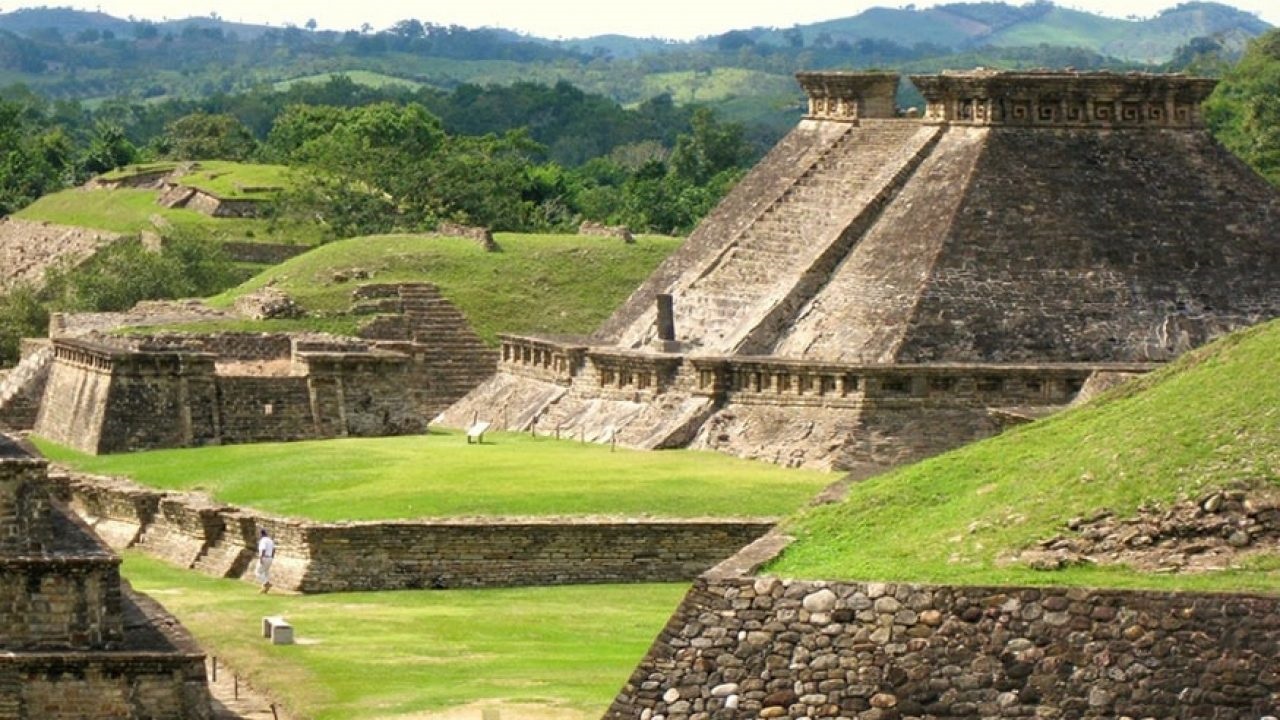
They also developed an automatic irrigation system that allowed water to be brought to less fertile land, so that it could be productive. Fishing and hunting are other economic actions generated by the Olmecs. Similarly, this civilization was known for raising turkeys, which were valuable for both their meat and feathers.
Religion
The Olmec culture was theocratic, meaning that the government was subject to religious and polytheistic authorities. Sculpture and architecture were doctrines subservient to religious habits; Olmec altars, temples and idols are proof of this. Among their cult objects, the jaguar was perhaps the most important, who was also considered the god of the Earth.
The Jaguar men were also very relevant. Some sculptures show half-human, half-jaguar deities. Other deities were the god of fire, the god of wheat, the god of death, and the feathered serpent. In the Olmec culture, there was the figure of the shaman, responsible for directing religious rituals and to whom healing abilities were attributed.
Art
Sculpture is one of the most typical artistic specialties of the Olmecs. Its best monuments are called "the giant heads", images carved in stone (mostly basalt and adorned with jade), which can measure up to 3,4 meters.
Today, it is believed that they were made in honor of the most famous chieftains, fighters and ancestors of civilization. The first head was discovered in 1862 in southern Veracruz.
There are two things that are repeated in Olmec artistic representations: the use of jade and the symbol of the jaguar. The latter was considered a symbol of power not only by the Olmec culture but also by other indigenous cultures in Central America.
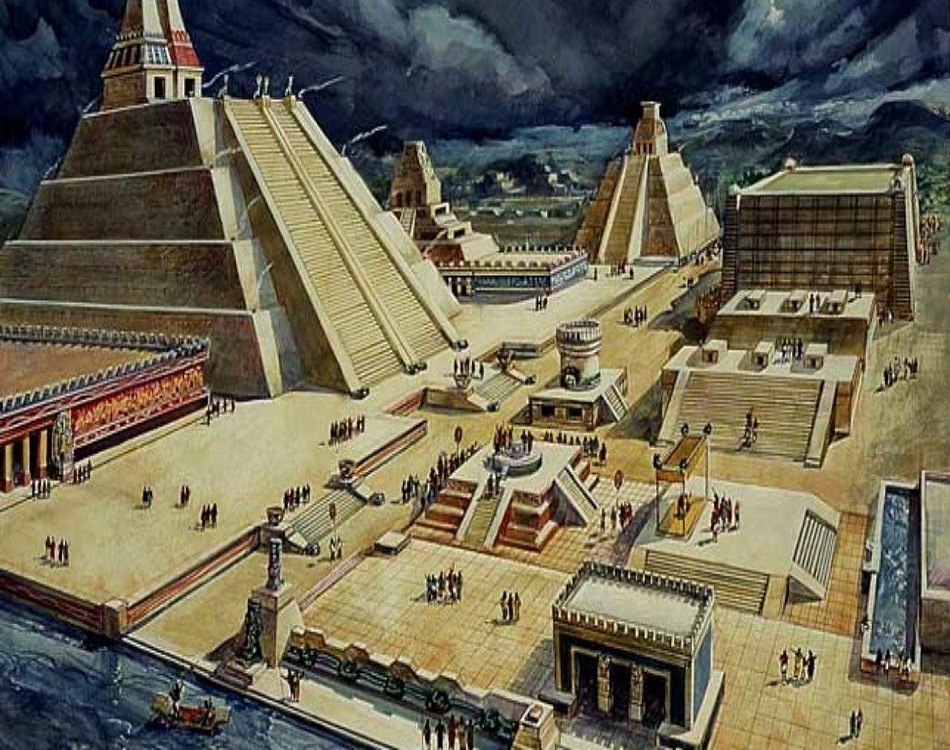
Mexica/Aztec culture
The Mexicas, also called Aztecs, were originally a nomadic people who arrived in Mesoamerica in the XNUMXth century. This tribe would have been considered inferior by other Central American civilizations because it was nomadic.
However, by the XNUMXth century, the Aztecs had already assimilated the cultures around them and laid the groundwork to build what would later be known as the Aztec Empire.
They adapted to the environment in which they had to live; they built canoes to be able to subsist fishing in nearby waters; They worked the land to make it fertile and productive, and built dams and irrigation systems.
When they were fully established, they began to create an empire by conquering other minor tribes. These conquered tribes were supposed to pay homage to the Aztecs.
In this way, they guaranteed another source of food and goods (such as jewelry, clothing), as well as prisoners sacrificed to feed the gods.
At the beginning of the XNUMXth century, the Aztec civilization was considered one of the most powerful in Mesoamerica and included central and southern Mexico, as well as the territories of Nicaragua and Guatemala.
Origin and location
In Nahuatl, Aztec means "the people who came from Aztlán." According to a Mexican myth, its people left Aztlán until they found their new place by building the city of Tenochtitlán. They decided to call this place Mexihco, which means “in the navel of the moon”, where the Mexicas come from.
Therefore, the fundamental difference is that the Aztecs would be the ones who would migrate, but once established, they were called Mexica. On the other hand, it is important to remember that this origin in Aztlán is a myth. The geographic location of the Mexicas extended over the center and south of present-day Mexico. Its origins go back to the dates after the fall of the Toltec empire, between the XNUMXth and XNUMXth centuries.
The reality of the origin of the Mexicas consisted of a great immigration of Nahuatl-speaking groups from the north of present-day Mexico -Chichimeca-, which flooded the central plateau of Mexico, around Lake Texcoco. They were among the last populations to arrive in the area, so they were forced to occupy the swampy area to the west of the lake.
Their religious belief in the legend that a powerful people would arise in a swampy area where there was a cactus and an eagle devouring a snake, was what allowed them to hang on and prosper in the area. This tradition continues today and can be seen, among other things, in Mexican bills and coins. In 1325, they founded Tenochtitlán, located in what is now the capital of Mexico.
Around the riverside lake, they developed a system of gardens called chinampas, which were logs resting on the sand that formed artificial islands. Roads and bridges were built to drain the region and connect it to the mainland.

In its splendor, there were 38 tributary provinces, but the most remote provinces fought for their independence, so they allied with Hernán Cortés and unfortunately facilitated the disappearance of the Aztec people.
Agriculture
Agriculture was the base of the Mexican economy. They developed the cultivation of corn, which was the most important food, as well as peppers, beans, tobacco and cocoa.
They practiced the slash and burn system, which generated positive results. They also built irrigation canals that allowed them to plant in less fertile areas.
Education
Mexican children were homeschooled from the age of three. Fathers educate boys while mothers educate girls. At the age of 15, young noblemen can begin their studies at the Tenochtitlan school, Calmecac.
This school has trained wealthy young people in the fields of medicine, astronomy, calculus, writing, history, literature, philosophy, law, business management of state and military strategy.
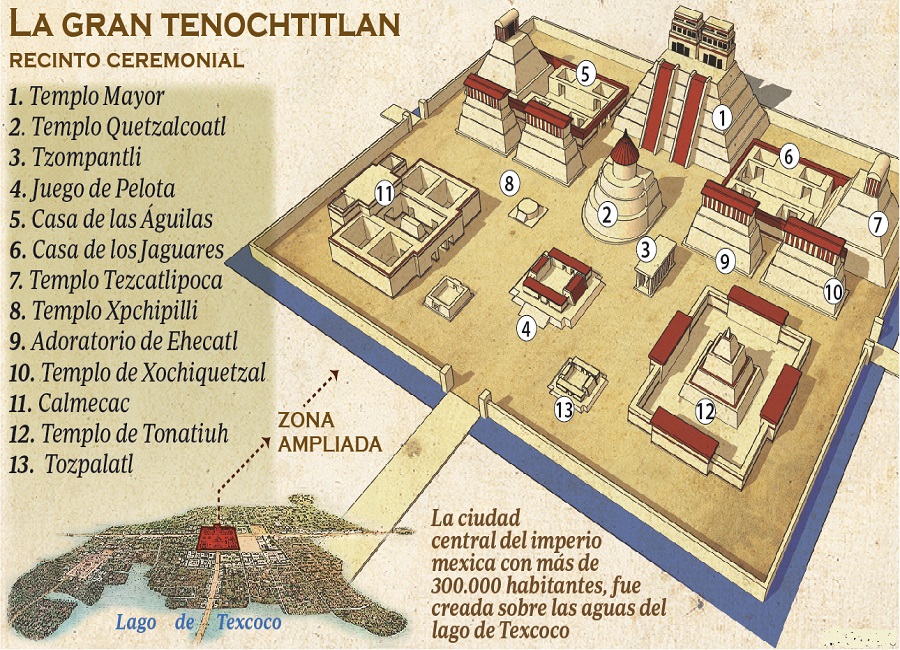
Middle-class youth attended the Telpochcalli School, where they learned to work stone, sculpt, and become warriors.
For their part, the young women were educated as priestesses and learned to weave, work with feathers and make religious objects.
The code of conduct
A relevant part of Mexican education and way of life is the code of conduct that is taught in all schools and is even part of a written law. Violation of any of these rules could be paid with life.
Here is a list of some of the behavior code rules:
1- Do not make fun of the elderly.
2- Do not make fun of the sick.
3- Do not interrupt when another is speaking.
4- Do not complain.
Religion
Religion was an important part of Mexican culture. They were polytheistic because they worshiped various gods and goddesses who represented elements of everyday life. Some of them are the God of the Sun and the Goddess of the Moon, the God of Rain and the God of Fertility.
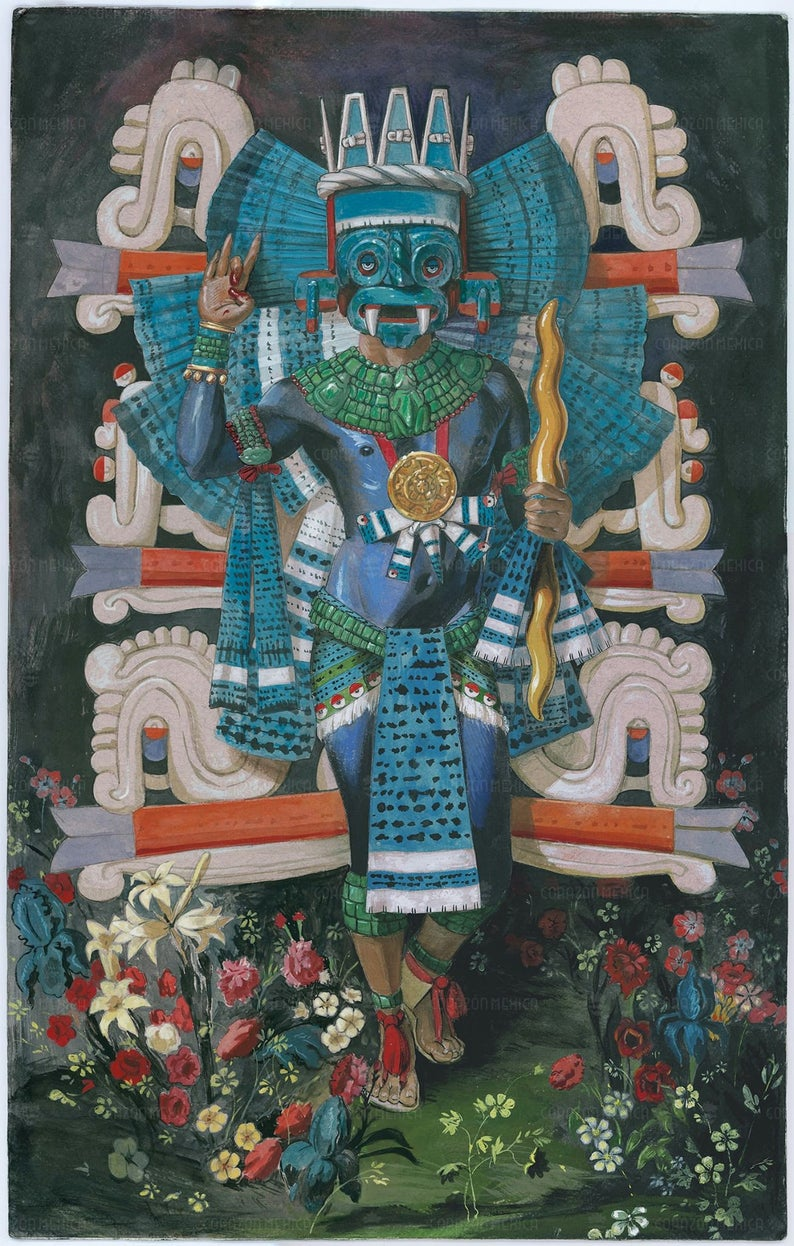
Their religious beliefs made the Mexica considered bloodthirsty because they made human sacrifices to satisfy the need for human blood that some gods had. For example, Huitzilopochtli, the sun god, had to feed continuously on blood; otherwise he would stop going out every day.
Religion was linked to all aspects of Aboriginal life. For example, they started wars against other tribes in order to have a continual supply of prisoners who could be sacrificed whenever the gods wished. Similarly, religion was closely linked to architecture. Above the pyramids, the Aztecs built temples to worship their gods and make sacrifices.
mexican gods
Some of the most important gods were:
-Quetzalcóatl: is the god of nature, including the earth and the sky. His name means "feathered serpent".
–Chalchiuhtlicue: is the goddess of water bodies, lakes, oceans and rivers.
–Chicomecoatl: is the goddess of corn.
–Mictlantecuhtli: is the god of death. He is usually depicted with a skull in the face position.
–Tezcatlipoca: he is the god of the sky and the night wind. He is usually related to black stones like obsidian.
Mayan culture
The Mayan culture, developed in the territory currently divided between Mexico, Guatemala, Belize, Honduras and El Salvador, is possibly one of the most brilliant and successful civilizations. This prestige is due to the fact that they have developed various fields of knowledge, including astronomy, writing, and mathematics.
Agriculture was essential in the Mayan economy, with maize being the main crop. Cotton, beans, cassava, and cocoa were also grown. Its textile techniques have reached a high degree of development.
The commercial exchange of this city was through cocoa beans and copper bells, a material that was also used for ornamental works. Like gold, silver, jade, among others.

The monumental ruins of Palenque, Mayapán, Copán, Tulún and Chichén Itzá, among many others, allow us to know with certainty the type of architecture that was used at that time, describing three styles: the Bec River, the Chenes and the Puuc.
The distribution of the cities was based on stepped pyramidal structures covered with blocks, crowned by a temple and around them there were open plazas.
Economy
The Mayans systematized agriculture. The archaeological remains testify to a great development in relation to this area; There are canals in the Valley of Guatemala that show the use of irrigation systems in the highlands.
Meanwhile, in the lowlands, water systems were used to cultivate the swampy areas. Like other Mesoamerican civilizations, they developed the cultivation of corn, beans, pumpkins, and sweet peanuts. They practiced slash and burn.
Architecture
The Mayan civilization built temples and ceremonial centers; The pyramids are the maximum representation of architecture. For their constructions, they used stone. Mainly lime, a material that has been carved to create bas-reliefs as an ornament.
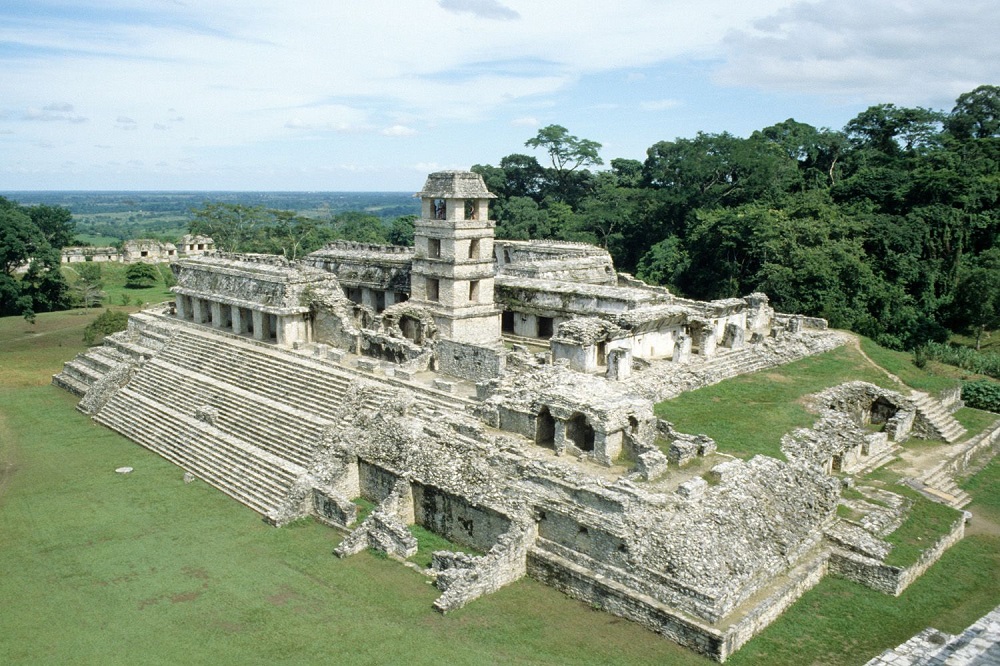
These bas-reliefs appeared, among other things, scenes of Mayan life, especially events of great importance in the life of the rulers.
mayan inventions
The Mayans were successful in various fields of knowledge and made great contributions. With respect to writing, the Mayans generated a hieroglyphic system that, unlike pictorial writing, represented spoken language.
This system was made up of symbols that represented syllables and sometimes words. Examples of this writing can be enjoyed in his books, known as the Codex.
Similarly, the Mayans had mathematical knowledge, especially in astronomy, which allowed them to build various calendars. One was based on the solar year, which lasted 18 months (20 days each) and an additional five days, considered unlucky.
Another was the sacred calendar that had 260 days, divided into 13 cycles, used to mark the start of religious festivals and predict destiny.
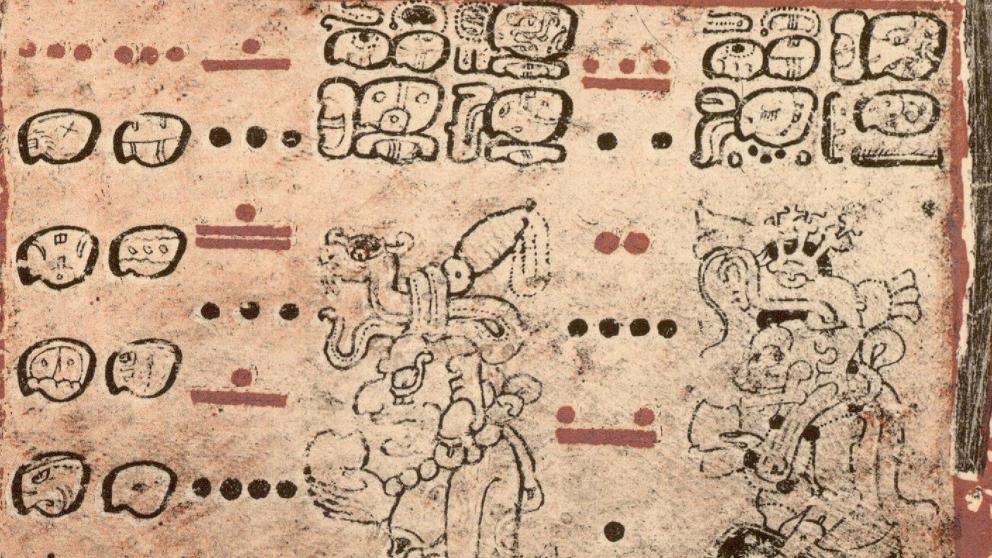
They also created graphs with the position of the moon and Venus, allowing them to accurately predict when there would be a solar eclipse.
Religion
The Mayan religion was polytheistic, with various gods, and is based on the cyclical perception of time, resulting in the belief in reincarnation. Because the aborigines depended on maize crops, the maize god was of vital importance.
Torture and human sacrifice were religious rituals, although they were not as common or lavish as those practiced by the Aztecs. These rituals were believed to ensure fertility and make the gods happy. Otherwise, chaos would take over the world.
The Mayans considered that the blood resulting from the sacrifices fed the gods and, therefore, it was necessary to establish contact with them. Furthermore, self-sacrifice and flagellation were common practices among priests and nobles.
The role of women
It is important to note that, unlike other cultures of the time, women actively participated in Mayan society. They are not limited to caring for and educating children, but may also engage in economic and government activities.
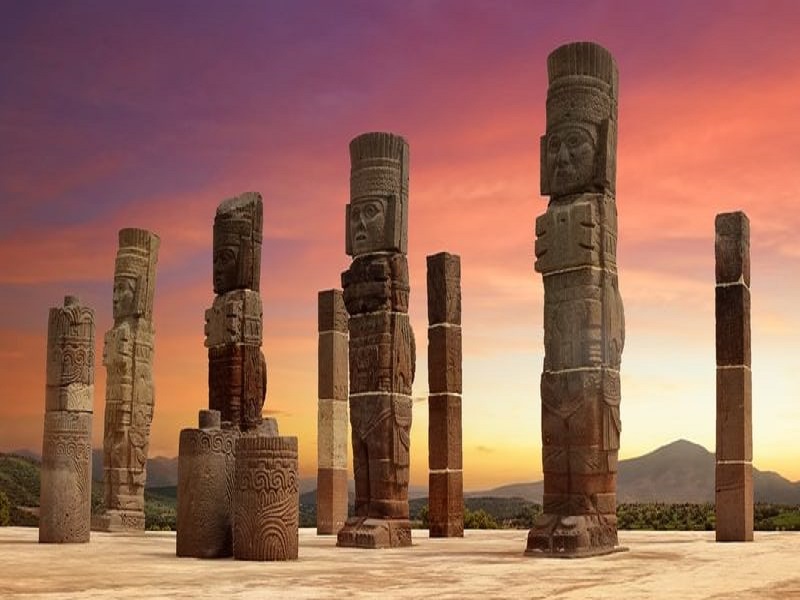
toltec culture
The Toltecs ruled the northern highlands of Mexico in the XNUMXth and XNUMXth centuries. Its main population centers were Huapalcalco in Tulancingo and the town of Tollan-Xicocotitlan, located in what is now known as Tula de Allende, in the state of Hidalgo. Its name comes from the Nahuatl meaning "inhabitant of Toula".
A great influence was in the architecture, which the Mayans refined into the styles present in Chichen-Itza, the castle and the temple of the warriors. They are especially famous for their giant statues called Atlanteans.
Teotihuacan culture
The Teotihuacan culture began to evolve in colonies around the year 100 BC. C. in what will be a few centuries later the metropolis of Teotihuacan. Its heyday occurs at the beginning of the classic period of Mesoamerica (art. II / III-VI).
It is the most enigmatic of the Mesoamerican civilizations, because its disappearance was long before the arrival of the Spanish and there is no trace of its existence.
Even the same Mexicans who were near the town of Tenochtitlan knew very little about the Teotihuacanos, since this culture was born after their disappearance.

It is known that this civilization built the city of Teotihuacán. This name was given by the Aztecs and means "place where the gods were born" because they found it abandoned and believed that it was the cornerstone of the universe. In its heyday, it was a metropolis of more than 100,000 people and the nerve center of Mesoamerica.
It is the Mesoamerican civilization with the most religious ceremonial centers, which were monumental, highlighting the Temple of Quetzalcóatl, the Pyramid of the Moon and the Pyramid of the Sun, which is the third largest in the world.
The change from religious to military motives in their trades served to establish the hypothesis that a war was the cause of their decline.
Other notable Mesoamerican cultures
In addition to the Mesoamerican cultures, already named above, there were other aboriginal cultures in the area.
Purepecha culture
Known to the Spanish colonizers as a Tarascan culture, they settled primarily in the Michoacán region. They were engaged in agriculture, hunting, food gathering and crafts.
Characteristics of the Purépechas
From many points of view, the Purépecha people are considered an advanced civilization during the era of pre-Hispanic Mexico. They are dedicated to many trades such as architecture, painting, goldsmithing and fishing.
Already in the fifteenth century, they mastered the handling of metal, which finally meant the opening of several commercial relationships.
cultural expansion
They managed to spread their culture in Mesoamerica until the mid-1500s, when the arrival of the Spanish meant the almost immediate demise of the Empire.
Despite having fought many battles with the Aztec Empire (which could never conquer it), the Spanish Empire managed to bring them under control.
Although their culture and people managed to survive, much of their infrastructure was destroyed and their rulers assassinated.
Customs and traditions
Like most Mexican civilizations, they had many customs related to the worship of the natural elements that surrounded them.
Since their favorite food was corn, it was considered a good opportunity to plant corn of different colors and accompany them with beans to have a good harvest season and prosperity for the rest of the year.
Religion
Polytheistic in character, they believed that the universe was divided into three main parts: heaven, earth, and the underworld.
Three deities have risen above the others:
–Curicaveri, god of war and the sun, who made human sacrifices and whose symbol was birds of prey.
-His wife Cuerauáperi, goddess of creation, to whom rain, life, death and drought are attributed.
-His daughter, Xaratanga, goddess of the moon and the ocean.
Language
The Purépecha language is highly atypical, as it has no linguistic connection to any of the other dialects spoken by other Mexican populations and civilizations of the same period.
Huastecs
Located on the coast of the Gulf of Mexico, they were descendants of the Mayans. They are not a particularly well-defined culture due to their miscegenation, with the Teenek tribe having the most cultural significance. It is estimated that the first settlements occurred between 1500 a. C. and 900 a. c.
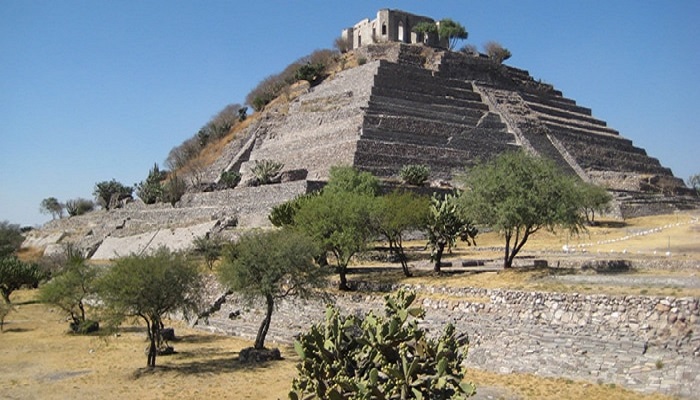
Main features
The expression huasteco comes from the Nahuatl word "cuextécatl", which can have two possible meanings: "small snail", if it comes from cuachalolotl, or "guaje", if it comes from "huaxitl"
The Spanish clergyman Fray Bernardino de Sahagún wrote that "The name of all these took from the province they call Cuextlán, where those that are populated are called" Cuextecas ", if there are many, and if one" Cuextecatl "and by another name" Toveiome "when there are many, and when" Toveio ", whose name means" our neighbor ".
Cranial deformity and lobe perforation
One of the most notable features of the Huasteca culture was the custom of deforming the skull, perhaps for ritual reasons. In addition, the ears have also been pierced to adorn them with bone and shell elements.
Nakedness
Although this is not 100% confirmed, many experts affirm that the Huastecs were naked. The source of this information was the writings found in archaeological excavations. On the other hand, current Huastecs generally wear covering dresses.
Language
The language most spoken by the Huastecos is the Teenek or Huasteco dialect. In addition, the use of Nahuatl and Spanish is also very common. The first of these languages is of Mayan origin, although it is thought that this part began to separate thousands of years ago. The Huastèques, in their language, are called Teenek, which means "men from here."
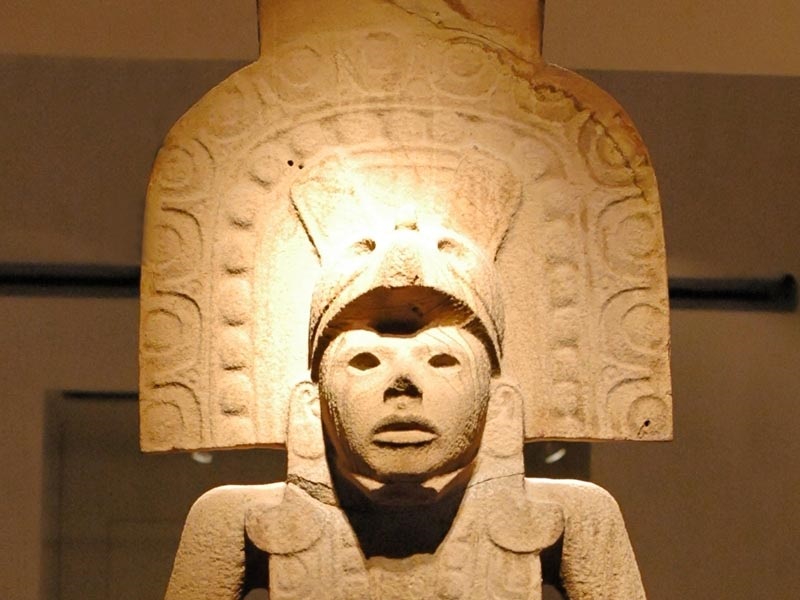
Multilingual
Currently, three indigenous languages are still spoken in the Huasteca region: Nahuatl, in Veracruz and part of San Luis Potosí; the Huasteco, in San Luis Potosí, north of Veracruz and in Tamaulipas; and pame, a dialect used in the mountainous area that separates San Luis Potosí and Querétaro
Tlaxcalans
They owe their name to the fact that they settled mainly in Tlaxcala. They were born from the union of several tribes in the region, becoming one of the main civilizations of Mexico before the conquest of the Spanish.
Scientific and cultural contributions.
One of the characteristics that experts attribute to the Tlaxcalan culture is its strong patriotic sentiment, especially when compared to other civilizations in the region.
This sentiment was reflected in all their festivals and ceremonies not related to religion. In them, they expressed their confidence in the good future of their homeland.
Some historians claim that this attitude, close to modern nationalism, explains his choice to ally with the Spanish against the Aztecs. At that time, the threat to the independence of Tlaxcala was the Mexica Empire, so they decided to reach an agreement to defeat it.
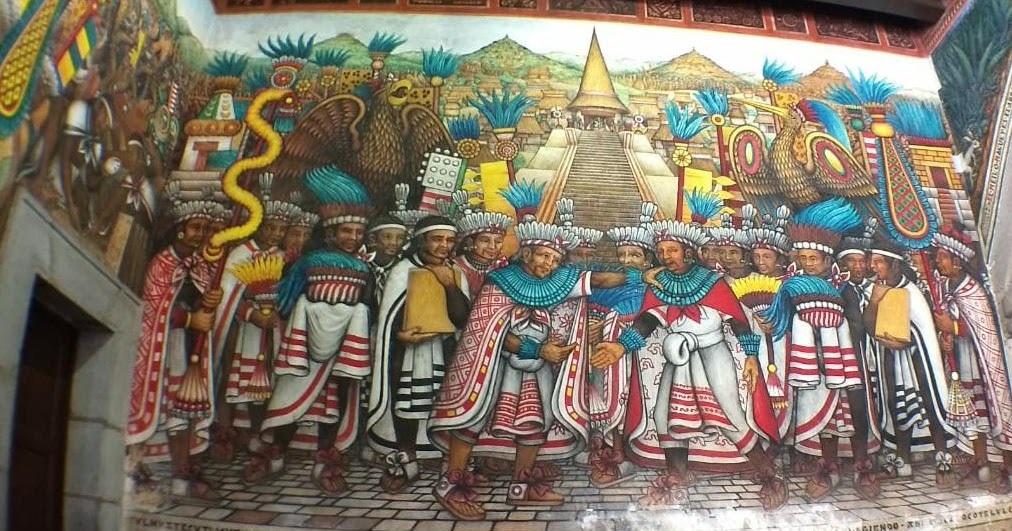
Tlaxcala Canvas Print
The Ayuntamiento de Tlaxcala commissioned the development of a colonial codex of Tlaxcala in the second half of the XNUMXth century. The result was the so-called Canvas of Tlaxcala.
The limited information available on the codex indicates that three copies of it were produced. One of them was to be sent to the King of Spain as a gift; another was destined for Mexico, where it was to go to the viceroy; and the third would remain in the Tlaxcalteca chapter itself.
Unfortunately, all these copies have been lost, so their content is only known from a reproduction made much later, in 1773. According to this reproduction, the codex showed some important aspects of culture, society and alliances. of the Tlaxcalans.
Literature
The writers of Tlaxcala were characterized by their good use of the language. These authors have cultivated all genres, from poetry to speeches and stories. The best known works are Tecuatzin and Tlaxcaltecayotl.
On the other hand, theatrical performances were also frequent. The main theme was his daily life, as well as the deeds of his warriors and gods.
https://youtu.be/TPKdF_st_pE
The popularity of the theater prompted performances to continue into colonial times. In addition to the authors of the texts.
architecture and sculpture
In the time before the Spanish conquest, the Tlaxcalans made their fortresses and other buildings with lime and stone. Normally, they chose hills to locate them, as in the cases of Cacaxtla and the ceremonial center of Xochitécatl.
In the case of sculpture, the Tlaxcalan authors were distinguished by the rigidity of their creations. They represented animals, men and gods.
Shortly before the Spaniards arrived, the Puebla-Tlaxcalteca area achieved considerable prestige for its polychrome pottery. Many experts consider that their pieces presented more variety and quality than those made by the Aztecs.
Music
As in most pre-Hispanic towns, music played a very important role in Tlaxcalan culture. According to experts, the compositions maintained a very fast rhythm, but atonal.
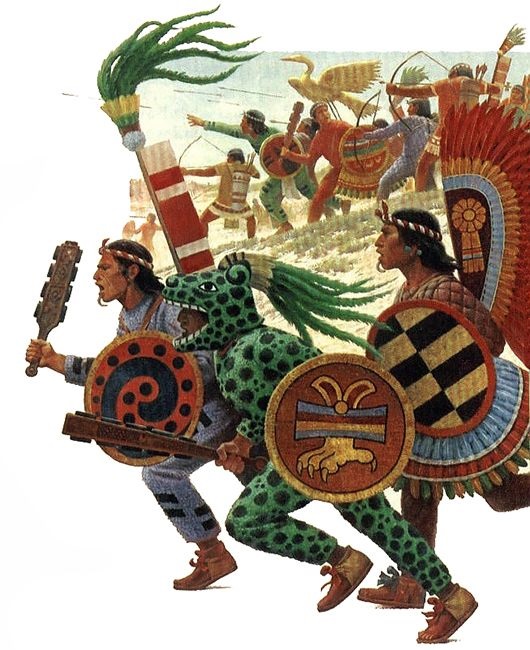
The most used instruments were the teponaztli and the huéhuetl. The first of them was a kind of drum made of wood. It included two reeds and produced two types of sounds.
On the other hand, the huéhuetl was another drum, in this case made of leather. Other Tlaxcalan artifacts were clay flutes, scrapers, and snails.
The music of this culture almost completely disappeared after the arrival of the Spanish. However, some of the instruments did survive.
Like dance, music was closely linked to religious ceremonies. According to the chronicles of the time, there were singers who accompanied the melodies with their songs.
Folk dances
As has been pointed out, the traditional Tlaxcalan dances were closely linked to their religious beliefs. This caused them to practically disappear when the Franciscans undertook their evangelizing work.
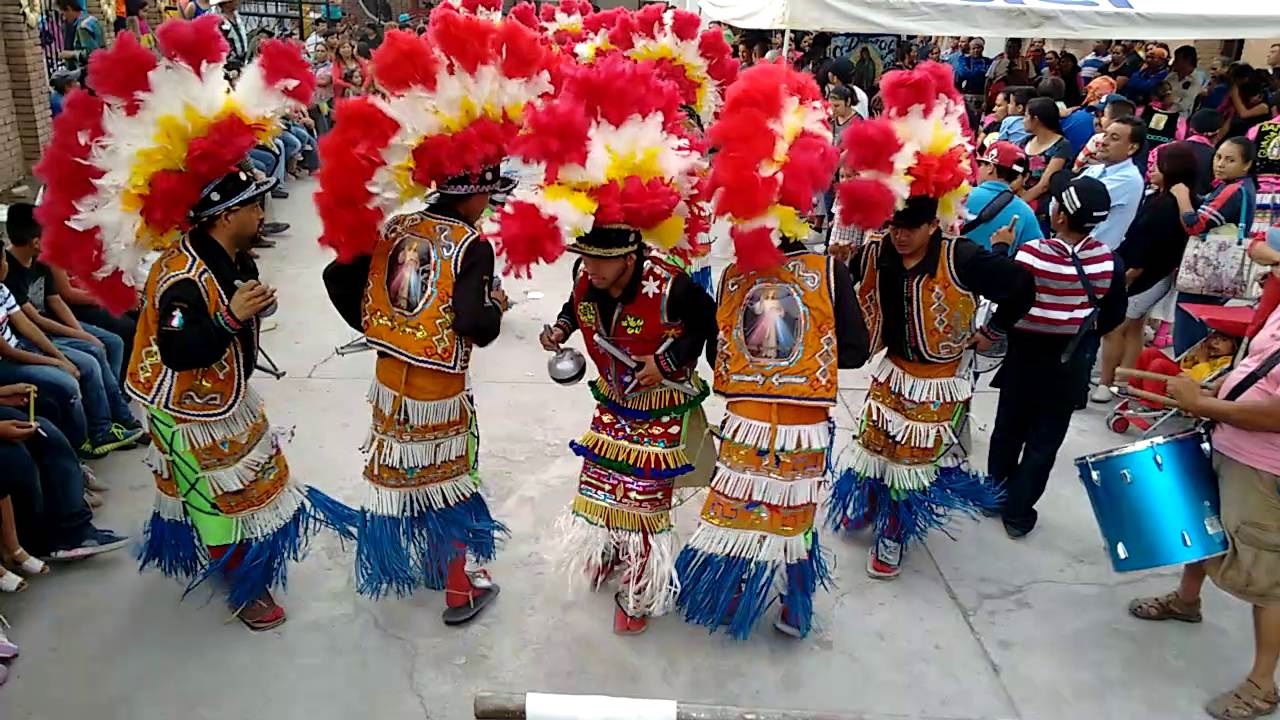
Instead of these dances dedicated to the ancient gods, especially Camaxtli, the Tlaxcalans began to dance other rhythms more suitable for the new Christian beliefs. Thus, dances such as the Moors and Christians or the Carnestolendas arose.
totonacas
The Totonacas arrived from the north of the country to settle in Veracruz and near the central regions. El Tajín, Papantla and Cempoala were its most important urban centers, which stand out for their great monumental value.
Main features
As noted, the Totonac culture brought together and incorporated many characteristics of other peoples, such as the Olmecs or the Teotihuacans. With these influences and their own contributions, they created an important civilization that spread to Oaxaca.
Etymology
The word "totonaca", according to the Nahuatl or Mexican dictionary, is the plural of "totonacatl" and refers to the inhabitants of the Totonacapan region. Some experts point out that “Totonac” could mean “man from the hot land”.
On the other hand, in the Totonac language, the expression has the meaning of “three hearts”, which would refer to the three great ceremonial sites established by this culture: El Tajín, Papantla and Cempoala.
Sociopolitical organization
There are few references to the social and political organization of the Totonac culture. The investigations carried out are based on archaeological findings and the most accepted theory is that it was a society divided into several social classes.
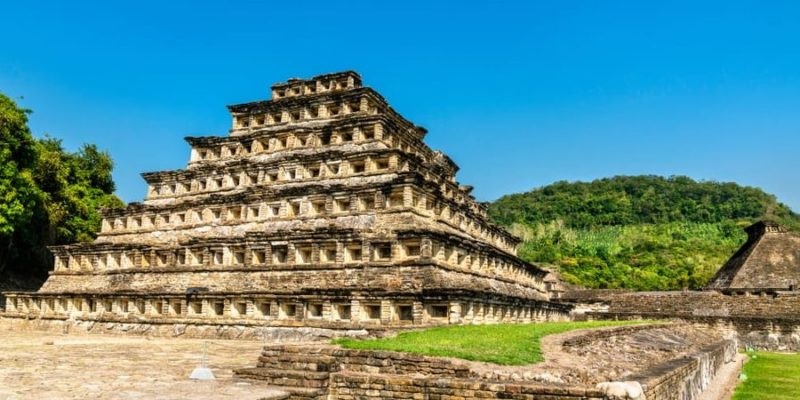
This social pyramid was directed by the nobility, made up of the Cacique in power, the rest of the authorities and the priests. They were all responsible for controlling all areas of power, from politics to religion to the economy. His government, as indicated, was headed by the Cacique, assisted by the Council of Elders. For their part, the priests have also played a major role in this culture. His duties included conducting ceremonial services, conducting astronomical observations, and performing ceremonies.
This religious caste was governed by the procurators (members of the Council of Elders) and, after them, the mayordomos (sponsors of festivals) and topiles (responsible for the maintenance of the temples). As for the base of the pyramid, it was made up of commoners, the majority of the inhabitants. They were in charge of agricultural production, crafts, fishing, and construction.
Meal
The Totonacs used the fertility of the land they inhabited to cultivate large areas of corn. However, unlike other pre-Columbian civilizations, this cereal was not the mainstay of their diet. This role was played by fruits such as sapodilla, guava, avocado or avocado.
According to experts, the peasants and nobles have agreed on the composition of their first meal of the day: corn porridge. As for lunch, those from the upper class ate stews with beans and yucca, seasoned with meat sauce. The poor, although they follow a similar diet, cannot afford these sauces.
In addition to these foods, humans are known to fish for sharks and hunt turtles, armadillos, deer, or frogs. For their part, the women raised dogs and turkeys. These two aspects lead us to think that these animals were incorporated into the diet.
Clothing
According to Brother Bernardino de Sahagún, a Franciscan missionary who came to learn Nahuatl to document native customs, Totonac women were very elegant and flamboyantly dressed. According to the believers, the nobles wore embroidered skirts, in addition to a small triangular poncho at chest height, called quexquemetl. Similarly, they adorned themselves with jade and shell necklaces and wore earrings and some sort of red makeup.
For their part, the men of the nobility wore capes of different colors, loincloths, labrets and other articles made of quetzal feathers.
Today, the women of this culture traditionally wear shirts, aprons, petticoats, belts, and quexquemetl. All this is done by the women themselves, as they retain the reputation of being excellent weavers.
Religion
As in other aspects, very little is known about the religion practiced by the Totonacs. Almost everything that is known comes from an essay by the researcher Alain Ichon in 1960. Among his conclusions, the complexity of the belief system of this culture stands out.
Gods
The Totonac religious world was made up of a large number of gods organized according to a hierarchy of importance. Thus, the following classes existed: the main gods; secondary; minor property owners; and the gods of the underworld. In total, they are believed to have added around 22 deities.
The most important god has been identified with the Sun, to whom human sacrifices were offered. Next to him was his wife, the corn goddess, who was good at animal sacrifices because she hated human sacrifices. Another important deity was "Old Thunder", called Tajin or Aktsini.
The Totonacas also incorporated into their pantheon gods common to those of other civilizations in Mesoamerica. Among them were Tláloc, Quetzalcóatl, Xochipilli or Xipetotec.
If you found this article from Mesoamerican Culture interesting, we invite you to enjoy these others: